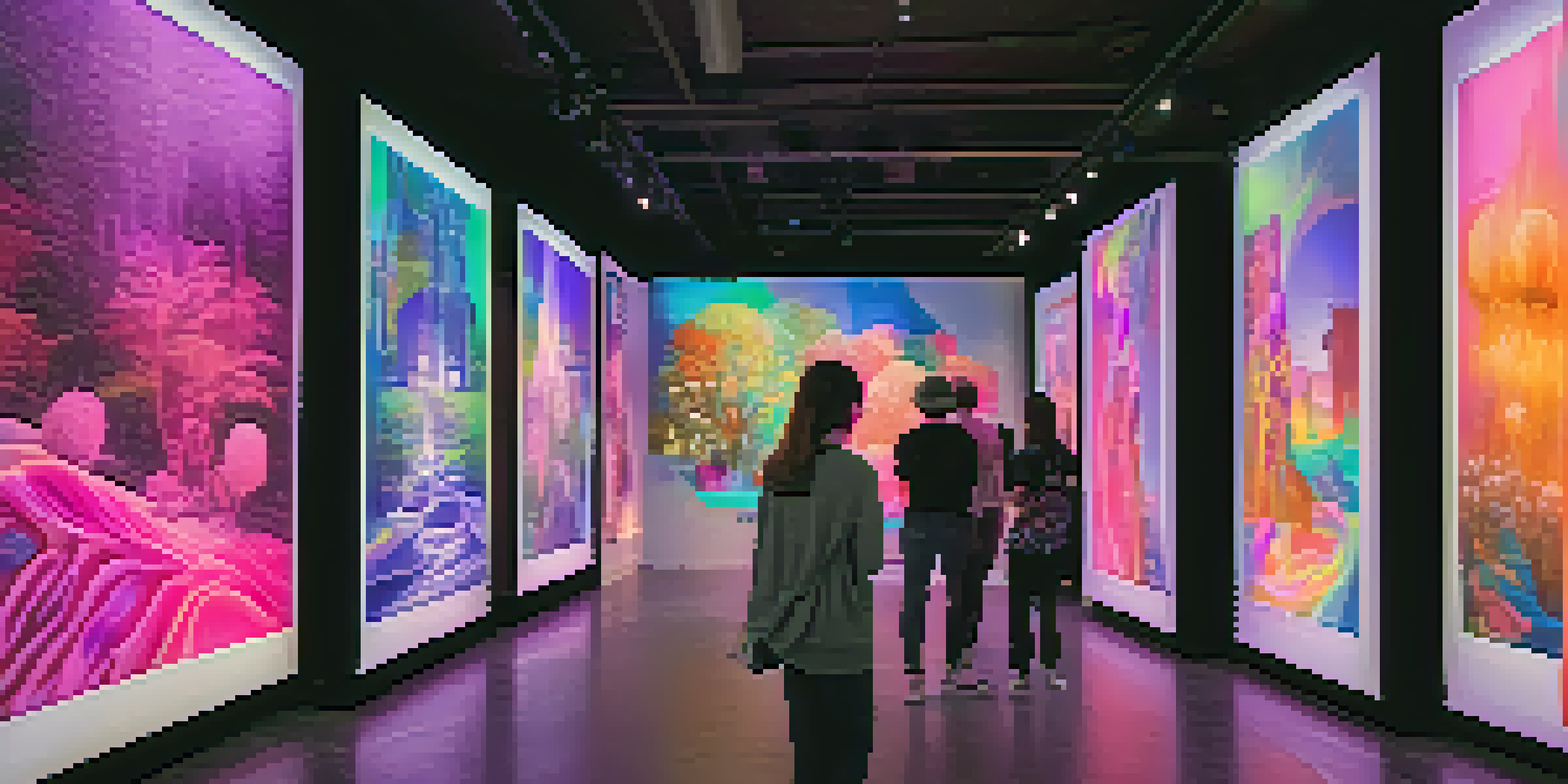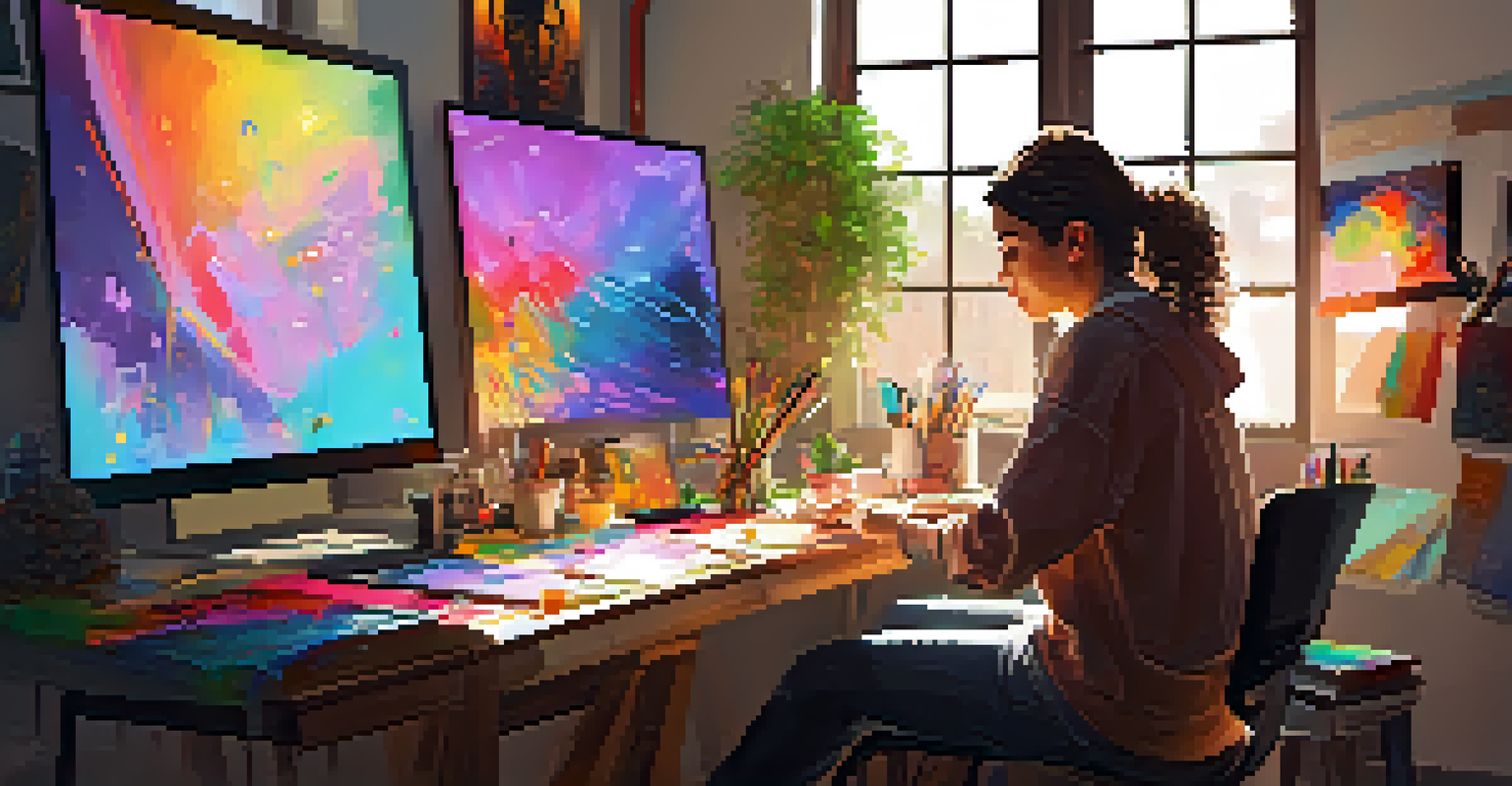How NFTs Enable Creators to Retain Control Over Their Work

What Are NFTs and Why Do They Matter?
NFTs, or non-fungible tokens, are unique digital assets that represent ownership of a specific item, often art or music. Unlike cryptocurrencies, which are interchangeable, each NFT is one-of-a-kind, making them perfect for creators looking to sell their work. This uniqueness is what allows artists to maintain a sense of ownership and authenticity in the digital space.
NFTs are a way for artists to take control of their work and define the terms under which it's shared and sold.
For many creators, the traditional art world can feel restrictive, with galleries and agents often controlling the narrative. NFTs disrupt this model by enabling direct sales to consumers, allowing artists to connect with their audience on their own terms. This shift not only democratizes the market but also gives creators the ability to retain a larger share of the profits.
As more people become aware of NFTs, their potential to revolutionize the creative industry becomes clearer. Artists can now reach a global audience without the need for intermediaries, making it easier than ever for them to showcase and monetize their work.
Retaining Ownership Through Smart Contracts
One of the most powerful features of NFTs is the use of smart contracts, which are automated agreements that execute when certain conditions are met. This technology allows creators to specify how their work can be used, preventing unauthorized reproduction or distribution. By embedding these terms directly into the NFT, artists can retain control over their creations even after a sale.

For example, a musician could sell an NFT of their song, and the smart contract could stipulate that they receive a percentage of any future sales or uses. This ensures that creators can continue to benefit financially from their work long after the initial transaction. It’s a game-changer for those who want to ensure ongoing revenue streams.
NFTs Empower Creators and Artists
NFTs provide a direct sales model that allows creators to connect with their audience and retain more profit.
Overall, smart contracts empower creators to enforce their rights without needing extensive legal resources. This autonomy is a major draw for many artists exploring the NFT space.
Direct Engagement with Fans and Collectors
NFTs foster a closer relationship between creators and their fans. Instead of going through galleries or record labels, artists can engage directly with their audience, building a community around their work. This direct connection can lead to increased loyalty and support, as fans feel more involved in the creative process.
The blockchain is not just a technology; it’s a new way for creators to assert ownership over their digital creations.
Social media platforms play a crucial role in this engagement, allowing creators to share their NFTs and interact with potential buyers. This interaction not only promotes the artwork but also humanizes the creator, making fans feel like they are part of a personal journey. As a result, the art becomes more than just a product; it transforms into a shared experience.
In essence, NFTs empower creators to cultivate relationships that extend beyond mere transactions. This connection can be invaluable for artists looking to build a sustainable career in a competitive landscape.
The Importance of Royalties for Continued Earnings
Another significant advantage of NFTs is the ability for creators to earn royalties on secondary sales. Unlike traditional art sales, where an artist receives a one-time payment, NFTs can be programmed to automatically pay a percentage of future sales back to the original creator. This ongoing revenue model ensures that artists are compensated fairly as their work appreciates in value.
Imagine an artist who sells an NFT for $100. If that NFT later sells for $1,000, the original artist can still receive a percentage of that profit through the smart contract. This not only incentivizes creators to produce high-quality work but also allows them to benefit from their growing reputation.
Smart Contracts Ensure Creator Rights
Smart contracts enable artists to maintain control over their work and earn royalties from future sales.
Ultimately, royalties provide a sustainable income stream that can be vital for artists trying to make a living. This financial security is one of the key reasons why many creators are gravitating toward the NFT landscape.
Establishing Provenance and Authenticity
In the digital age, concerns about authenticity and ownership are more prevalent than ever. NFTs address these issues by providing a verifiable record of ownership on the blockchain. This technology allows collectors to confirm the origin of a digital asset, ensuring that what they're purchasing is genuine and not a mere copy.
For creators, this means that their work is less likely to be misrepresented or pirated. The blockchain serves as a tamper-proof ledger, making it easy for collectors to trace the history of an NFT back to its original creator. This transparency helps build trust in the marketplace, which is essential for long-term success.
As more creators embrace NFTs, the importance of provenance will continue to grow. Establishing authenticity not only protects artists but also enhances the value of their work in the eyes of collectors.
Navigating the Challenges of the NFT Market
While the NFT market offers numerous benefits, it's not without its challenges. Many creators face a steep learning curve when it comes to understanding blockchain technology and the intricacies of NFTs. Additionally, the market can be volatile, with prices fluctuating dramatically based on trends and demand.
To navigate these challenges, artists should invest time in educating themselves about the market and its potential pitfalls. Joining online communities, attending workshops, and collaborating with other creators can provide valuable insights and support. This knowledge empowers artists to make informed decisions about their work and how they choose to market it.
Provenance Builds Trust in Digital Art
The blockchain technology behind NFTs verifies ownership, ensuring authenticity and protecting artists' work from piracy.
Ultimately, while the NFT landscape can be daunting, those who take the time to understand it can reap significant rewards. Embracing these challenges is part of the journey toward establishing a successful presence in the digital art world.
The Future of NFTs and Creative Control
As technology continues to evolve, the potential for NFTs to reshape the creative landscape is immense. Many experts predict that NFTs will become increasingly integrated into various industries, from music to fashion. This growth opens up exciting opportunities for creators to explore new ways of showcasing and monetizing their work.
Moreover, as consumer awareness of NFTs rises, creators will have even more platforms to share their art. This democratization of the creative process encourages innovation and experimentation, allowing artists to push the boundaries of their craft. The future of NFTs presents endless possibilities for those willing to adapt and evolve.

In conclusion, NFTs are not just a passing trend; they represent a fundamental shift in how creators retain control over their work. As this technology continues to develop, it will empower a new generation of artists to thrive in the digital age.